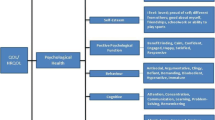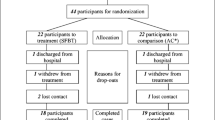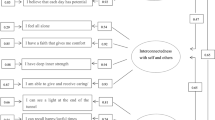Abstract
Objective
Children with life-threatening medical conditions frequently undergo invasive medical procedures that may elicit anxiety and distress. However, there are few empirically validated interventions that reduce mental health symptoms and increase the resilience of children during the acute stages of illness. This study aimed to evaluate the efficacy of the Make a Wish intervention for children with life-threatening cancer.
Methods
The design was a wait-list-controlled trial with two parallel groups. Sixty-six children aged 5–12 with an initial diagnosis of life-threatening cancer were identified and randomly assigned to the Make a Wish intervention (n = 32) or a wait-list control group (n = 34). Children completed measures of psychiatric and health-related symptoms, positive and negative affect, hope, and optimism pre-intervention and post-intervention. After baseline data collection, children were interviewed and made an authentic wish that they wanted to come true. These wishes were made possible 5–6 months after baseline data collection, to fuel anticipation and excitement over the wish-fulfillment event. The post-intervention assessment point was 5 weeks after wish fulfillment (approximately 7 months after baseline data collection).
Results
Children in the intervention group exhibited a significant reduction in general distress (d = 0.54), depression (d = 0.70), and anxiety symptoms (d = 0.41), improved health-related quality of life (d = 0.59), hope (d = 0.71), and positive affect (d = 0.80) compared to decrease in positive affect and no significant changes in the other measures in the control group.
Conclusions
These findings emphasize the role of hope and positive emotions in fostering the well-being of children who suffer from serious illnesses.



Similar content being viewed by others
References
Howlader, N., Noone, A. M., Krapcho, M., Garshell, J., Miller, D., Altekruse, S. F., et al. (Eds.). (2014). SEER cancer statistics review, 1975–2011. Bethesda, MD: National Cancer Institute. Retrieved on January 27, 2015 from http://seer.cancer.gov/csr/1975_2011/.
Collins, J. J., Byrnes, M. E., Dunkel, I. J., Lapin, J., Nadel, T., Thaler, H. T., et al. (2000). The measurement of symptoms in children with cancer. Journal of Pain and Symptom Management, 19(5), 363–377. doi:10.1016/S0885-3924(00)00127-5.
Vance, Y. H., & Eiser, C. (2002). The school experience of the child with cancer. Child: Care, Health and Development, 28(1), 5–19. doi:10.1046/j.1365-2214.2002.00227.x.
Curtis, C. E., & Luby, J. L. (2008). Depression and social functioning in preschool children with chronic medical conditions. The Journal of Pediatrics, 153(3), 408–413. doi:10.1016/j.jpeds.2008.03.035.
Pao, M., & Bosk, A. (2011). Anxiety in medically ill children/adolescents. Depression and Anxiety, 28(1), 40–49. doi:10.1002/da.20727.
Griffiths, M., Schweitzer, R., & Yates, P. (2011). Childhood experiences of cancer an interpretative phenomenological analysis approach. Journal of Pediatric Oncology Nursing, 28(2), 83–92. doi:10.1177/1043454210377902.
Germann, J. N., Leonard, D., Stuenzi, T. J., Pop, R. B., Stewart, S. M., & Leavey, P. J. (2015). Hoping is coping: A guiding theoretical framework for promoting coping and adjustment following pediatric cancer diagnosis. Journal of Pediatric Psychology. doi:10.1093/jpepsy/jsv027.
Williams, N. A., Davis, G., Hancock, M., & Phipps, S. (2010). Optimism and pessimism in children with cancer and healthy children: Confirmatory factor analysis of the youth life orientation test and relations with health-related quality of life. Journal of Pediatric Psychology, 35(6), 672–682. doi:10.1093/jpepsy/.
Chaves, C., Hervas, G., García, F. E., & Vazquez, C. (2015). Building life satisfaction through well-being dimensions: A longitudinal study in children with a life-threatening illness. Journal of Happiness Studies. doi:10.1007/s10902-015-9631-y.
Kim, D. H., & Yoo, I. Y. (2010). Factors associated with resilience of school age children with cancer. Journal of Pediatrics and Child Health, 46(7–8), 431–436. doi:10.1111/j.1440-1754.2010.01749.x.
Grootenhuis, M. A., & Last, B. F. (2001). Children with cancer with different survival perspectives: Defensiveness, control strategies, and psychological adjustment. Psycho-Oncology, 10(4), 305–314. doi:10.1002/pon.529.
Connor-Smith, J. K., Compas, B. E., Wadsworth, M. E., Thomsen, A. H., & Saltzman, H. (2000). Responses to stress in adolescence: Measurement of coping and involuntary stress responses. Journal of Consulting and Clinical Psychology, 68(6), 976. doi:10.1037/0022-006X.68.6.976.
Phipps, S. (2007). Adaptive style in children with cancer: Implications for a positive psychology approach. Journal of Pediatric Psychology, 32, 1055–1066. doi:10.1093/jpepsy/jsm060.
Whitney, S. N., McCullough, L. B., Frugé, E., McGuire, A. L., & Volk, R. (2008). Beyond breaking bad news: The roles of hope and hopefulness. Cancer, 113(2), 442–445.
Privette, G. (1983). Peak experience, peak performance, and flow: A comparative analysis of positive human experiences. Journal of Personality and Social Psychology, 45, 1361–1368. doi:10.1037/0022-3514.45.6.1361.
Derogatis, L. R., & Spencer, P. M. (1993). Brief symptom inventory: BSI. Upper Saddle River, NJ: Pearson.
Lavi, T., Green, O., & Dekel, R. (2013). The contribution of personal and exposure characteristics to the adjustment of adolescents following war. Journal of Adolescence, 36, 21–30. doi:10.1016/j.adolescence.2012.09.003.
Slone, M., & Shoshani, A. (2014). Psychiatric effects of protracted conflict and political life events exposure among adolescents in Israel: 1998–2011. Journal of Traumatic Stress, 27, 353–360. doi:10.1002/jts.21918.
Burnett-Ziegler, I., Walton, M. A., Ilgen, M., Barry, K. L., Chermack, S. T., Blow, F. C., et al. (2012). Prevalence and correlates of mental health problems and treatment among adolescents seen in primary care. Journal of Adolescent Health, 50, 559–564. doi:10.1016/j.jadohealth.2011.10.005.
Varni, J. W., Seid, M., & Kurtin, P. S. (2001). PedsQL™ 4.0: Reliability and validity of the Pediatric Quality of Life Inventory™ Version 4.0 Generic Core Scales in healthy and patient populations. Medical Care, 39(8), 800–812. doi:10.1097/00005650-200108000-00006.
Ebesutani, C., Regan, J., Smith, A., Reise, S., Higa-McMillan, C., & Chorpita, B. F. (2012). The 10-item positive and negative affect schedule for children, child and parent shortened versions: Application of Item Response Theory for more efficient assessment. Journal of Psychopathology and Behavioral Assessment, 34, 191–203. doi:10.1007/s10862-011-9273-2.
Scheier, M. F., Carver, C. S., & Bridges, M. W. (1994). Distinguishing optimism from neuroticism (and trait anxiety, self-mastery, and self-esteem): A reevaluation of the Life Orientation Test. Journal of Personality and Social Psychology, 67(6), 1063. doi:10.1037/0022-3514.67.6.1063.
Bamford, C., & Lagattuta, K. H. (2012). Looking on the bright side: Children’s knowledge about the benefits of positive versus negative thinking. Child Development, 83, 667–682. doi:10.1111/j.1467-8624.2011.01706.x.
Herth, K. (1992). Abbreviated instrument to measure hope: Development and psychometric evaluation. Journal of Advanced Nursing, 17(10), 1251–1259. doi:10.1111/j.1365-2648.1992.tb01843.x.
Slone, M., & Shoshani, A. (2008). Efficacy of a school-based primary prevention program for coping with exposure to political violence. International Journal of Behavioral Development, 32(4), 348–358. doi:10.1177/0165025408090976.
Slone, M., Shoshani, A., & Lobel, T. (2013). Helping youth immediately following war exposure: A randomized controlled trial of a school-based intervention program. The Journal of Primary Prevention, 34, 293–307. doi:10.1007/s10935-013-0314-3.
Cohen, J. (1988). Statistical power analysis for the behavioral sciences. Hillsdale, New Jersey: Psychology Press.
Fredrickson, B. L. (2004). The broaden-and-build theory of positive emotions. Philosophical Transactions-Royal Society of London Series B Biological Sciences, 359(1449), 1367–1378. doi:10.1098/rstb.2004.1512.
Reschly, A. L., Huebner, E. S., Appleton, J. J., & Antaramian, S. (2008). Engagement as flourishing: The contribution of positive emotions and coping to adolescents’ engagement at school and with learning. Psychology in the Schools, 45, 419–431. doi:10.1002/pits.20306.
Folkman, S. K., & Moskowitz, J. T. (2000). Positive affect and the other side of coping. American Psychologist, 55, 647–654. doi:10.1037//0003-066X.55.6.647.
Gallagher, M. W., & Lopez, S. J. (2009). Positive expectancies and mental health: Identifying the unique contributions of hope and optimism. The Journal of Positive Psychology, 4, 548–556. doi:10.1080/17439760903157166.
Barakat, L. P., Daniel, L. C., & Sills, R. H. (2014). Functional somatic symptoms in pediatric hematology and oncology. In R. D. Anbar (Ed.), Functional symptoms in pediatric disease (pp. 145–156). New York: Springer. doi:10.1007/978-1-4899-8074-8.
Fergusson, D., Aaron, S. D., Guyatt, G., & Hébert, P. (2002). Post-randomisation exclusions: The intention to treat principle and excluding patients from analysis. British Medical Journal, 325(7365), 652–654.
Heritier, S. R., Gebski, V. J., & Keech, A. C. (2003). Inclusion of patients in clinical trial analysis: The intention-to-treat principle. Medical Journal of Australia, 179(8), 438–440.
Acknowledgments
We would like to thank the families and the children who found the time and energy to participate in this study. We would also like to express our deepest gratitude to Denise Bar Aharon, Dorit Dovrat, and the Make a Wish Israel team for their help in this effort.
Author information
Authors and Affiliations
Corresponding author
Ethics declarations
Conflict of interest
The authors declare that they have no conflict of interest.
Ethical approval
All procedures performed in studies involving human participants were in accordance with the ethical standards of the institutional and/or national research committee and with the 1964 Helsinki Declaration and its later amendments or comparable ethical standards.
Informed consent
Informed consent was obtained from all individual participants included in the study.
Rights and permissions
About this article
Cite this article
Shoshani, A., Mifano, K. & Czamanski-Cohen, J. The effects of the Make a Wish intervention on psychiatric symptoms and health-related quality of life of children with cancer: a randomised controlled trial. Qual Life Res 25, 1209–1218 (2016). https://doi.org/10.1007/s11136-015-1148-7
Accepted:
Published:
Issue Date:
DOI: https://doi.org/10.1007/s11136-015-1148-7




